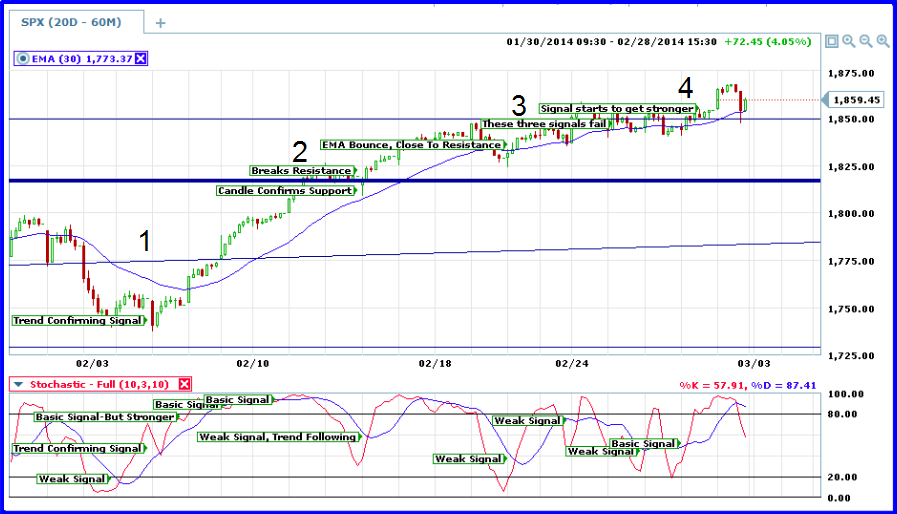30 Minute Stochastic Strategy For Trend Followers
Following the trend may not be cool in some parts of your life but it can be very profitable when speculating financial markets. This article is a follow up to a previous post I made called “Two Rules For Trading With Oscillators”. What are the two rules? Only take trend following signals and beware false breakouts. In the article I treated the group of oscillators as one indicator for educational purposes but now is the time to get down to the brass tacks and talk about my favorite oscillator, the Stochastic. The stochastic will give a number of different trend following signals that I will rank in order of importance and describe how I use them to trade. These methods can be used in any time frame but I prefer to use longer ones like daily or hourly. For forex binary options 30 minutes charts are preferred, especially for pairs that trade in tighter ranges.
Why should you only take trend following signals? Because they are much stronger. Think about it like this. When the ocean tide is rising is the next wave more or less likely to be higher than the next? Trend following signals take advantage of the markets own movement and are much more reliable than other types of signals in my opinion. I am going to assume that you already have an understanding of trend so I won’t bore you with that but just to touch base I use trend lines and the stochastic itself to predict trend.
The Basic Stochastic Trend Following Signal
The basic stochastic trend following signal is a simple signal line crossover. This signal occurs whenever the %K line crosses the %D line in line with the trend. Stochastic is displayed as two lines; %K which is the short term line and %D, the long term and signal line. In the case of an uptrend whenever the %K crosses below the %D and then moves back above it a buy signal is given. The reverse is true for a downtrend. It is also the weakest signal stochastic can give because it is not being confirmed in any way. Price action could be above or below resistance, extended far above the moving average or in the middle of a potential topping pattern. This does not mean that the signal is not good, just not strong. In order to make the most of this signal you should wait for a stronger signal and then use the basic signal for short term entries with several hours to end-of-day expiry.
A Much Stronger Stochastic Signal
A much stronger stochastic signal occurs following a pullback or correction of the trend. This is when your moving averages, trend lines and other trend measuring techniques come into play. After the pullback, most likely along some line of support/resistance that may include a trend line, Fibonacci Retracement or Bollinger Band, stochastic will give another basic signal. Only this time it is not so basic. A stochastic signal that occurs in line with a trend confirming bounce is much stronger than the basic signal and can be used as a starting point for using the basic signal for trade entries. Once the trend confirming signal occurs any basic signal can be taken as an entry until price action reaches resistance. Sometimes this signal can be hard to trade on because prices are (assuming bull market) in decline and testing or maybe even breaking support. Not to worry though, even if you miss the first signal there is another, much stronger trend confirming stochastic signal that may follow.
How To Trade The Strong Stochastic Trend Confirming Signal
It is not uncommon to miss the first signal. I often will wait for the trend confirming signal just because of its strength. Once price action has retreated to the trend line or support and has made the first strong trend following signal prices will often retest support. When this happens stochastic can confirm the move. Look at the chart of the S&P 500(Hourly) below. Starting on the left had side at position 1 there is a bottoming pattern that comes with a weak signal. After the weak signal prices retest support and at the same time stochastic confirms with the strong trend following signal. At that point prices move up for the next four days providing three more signals, averaging one signal per day.

Next you can see that prices meet resistance at position 2, stall for two days and then make a bounce from the moving average breaking resistance. Stochastic gives off a weak signal but I give it a weak(+) rating due to price action, trend, support line etc. Note that from here there is no strong signal given, only another weak one. Prices approach resistance at position 3 which is our warning to stop entering new trades. From here prices stall again, stochastic starts to fluctuate a little wildly in the near term and to diverge in the long term. The divergence confirms the previous warning not to trade. Notice how the next two weak signals fail to produce adequate movement to ensure profitability.
Now, the last signal on the chart at position 4 is very interesting. It is a little stronger than a weak signal but not a strong signal. I classify this as a basic signal for this reason. Both the %K and the %D lines are pointing up. All of the previous weak signals on this chart happened when %D was pointing down or flat at best. This signal resulted in a profit and has left the index sitting on support. Now it is time to watch for a confirmation of support from price action and from the stochastic. I use this strategy every day to trade every asset I watch. You can find out more about how I use stochastic to trade with the trend on my blog.